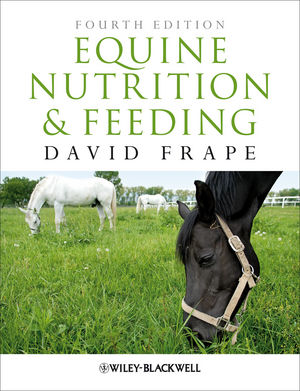Equine Nutrition and Feeding, 4th EditionISBN: 978-1-4051-9546-1
Paperback
514 pages
July 2010, Wiley-Blackwell
 This is a Print-on-Demand title. It will be printed specifically to fill your order. Please allow an additional 10-15 days delivery time. The book is not returnable.
|
||||||
Introduction to the Fourth Edition.
Acknowledgements.
List of Abbreviations.
1 The Digestive System.
The mouth.
The stomach and small intestine.
The large intestine.
Study questions.
Further reading.
2 Utilization of the Products of Dietary Energy and Protein.
Carbohydrate, fat and protein as sources of energy, and the hormonal regulation of energy.
Energy metabolism.
Dietary protein.
Protein requirements for maintenance.
Amino acids.
Non-protein nitrogen.
Laminitis and energy intake.
Study questions.
Further reading.
3 The Roles of Major Minerals and Trace Elements.
Major minerals.
Trace elements.
Study questions.
Further reading.
4 Vitamin and Water Requirements.
Vitamin requirements.
Water requirements and fluid losses.
Study questions.
Further reading.
5 Ingredients of Horse Feeds.
Roughage.
‘Processed’ feeds.
Functions of hay and use of other bulky feeds.
Compounded nuts.
Coarse mixes.
Cereals.
Other lesser ingredients and by-products.
Fat supplements.
Protein concentrates.
Pre- and pro-biotics.
Dietary vitamin and mineral supplements.
Feed storage.
Natural and contaminant toxicants in feeds.
Feed additives.
Prohibited substances.
Study questions.
Further reading.
6 Estimating Nutrient Requirements.
Relationship of capacity for feed to body weight.
Concentrates and roughages.
Feed energy.
Digestible energy, protein and mineral requirements based on NRC (2007) recommendations.
Ration formulation using the DE and NE systems.
Energy and protein requirements based on INRA feed units.
Energy, protein, mineral and micronutrient feed values as determined by the INRA system.
Simple ration formulation.
Feed type, rate of intake, appetite, frequency and processing.
Shelf-life of feeds, feed contaminants and government regulations.
Study questions.
Further reading.
7 Feeding the Breeding Mare, Foal and Stallion.
The oestrous cycle and fertility.
Gestation.
Parturition.
Lactation.
Weaning procedure.
Feeding the orphan foal.
The stallion.
Study questions.
Further reading.
8 Growth.
Ideal conformation.
Birth weight and early growth.
Later growth and conformational changes.
Effects of dietary composition.
Developmental orthopaedic disease.
Study questions.
Further reading.
9 Feeding for Performance and the Metabolism of Nutrients During Exercise.
Work and energy expenditure.
Energy substrates and their expenditure.
Training methods.
Muscle energy reserves and feeding before exercise.
The endocrine system.
The vascular and respiratory systems.
Results of exercise.
Blood acid–base balance.
Dietary base excess and ‘fixed’ dietary cation–anion balance.
Dietary protein requirements and exercise.
Feeding methods.
Study questions.
Further reading.
10 Grassland and Pasture Management.
Grassland types.
Pasture as an exercise area.
Nutritional productivity of pasture.
Nutrients required for pasture growth and development.
Sward height.
Intensity of stocking with horses and ruminants.
Grazing behaviour.
Supplements on pasture.
Safety of grazing areas.
Water supplies.
Silage and haylage and their safety.
Grassland improvement.
Tropical grassland and forages.
Poisonous plants.
Homeopathy.
Study questions.
Further reading.
11 Pests and Ailments Related to Grazing Area, Diet and Housing.
Arthropod parasites.
Worm infestations.
Protozoan parasites.
Ailments related to diet.
Pasture ailments.
Liver disease.
Chronic weight loss.
The mature sick or geriatric horse.
Muscle ailments.
Housing.
Study questions.
Further reading.
12 Laboratory Methods for Assessing Nutritional Status and Some Dietary Options.
Metabolic tests.
Diets for liver disease.
Diets for kidney disease.
Bone metabolism.
Other tests.
Procedures for determining causes of suspected nutritional problems.
Study questions.
Further reading.
Appendix A Example Calculation of Dietary Composition Required for a 400 kg Mare in the Fourth Month of Lactation.
Appendix B Common Dietary Errors in Studs and Racing Stables.
Appendix C Chemical Composition of Feedstuffs Used for Horses.
Appendix D Estimates of Base Excess of a Diet and of Blood Plasma.
Estimate of BE of a diet from its fixed ion content.
Estimate of BE of blood plasma from its bicarbonate concentration.
Glossary.
References and Further Reading.
Conclusion.
Index.



